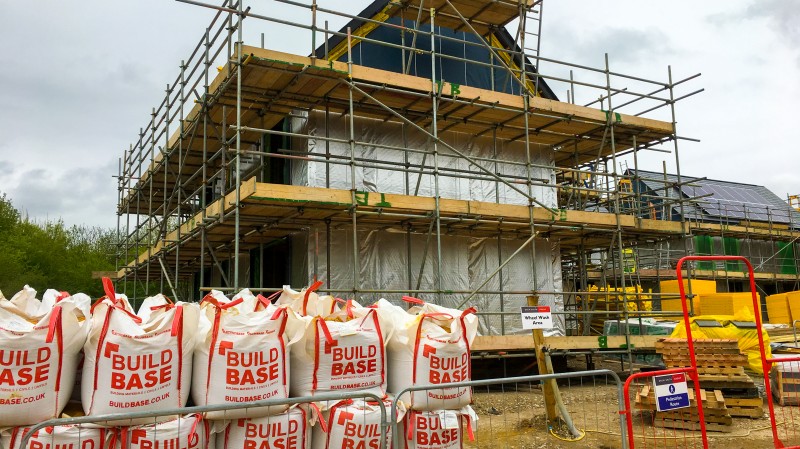You are here: Basement conversions: the only way is down
When space is at a premium digging deep may be the best solution.
Basements conversions are an increasingly popular home improvement project. The celebrities are famous for it from Andrew Lloyd Webber in Eaton Square to Damien Hurst in Ladbrook Grove. Today the subterranean building boom isn’t limited to the super-rich with their luxury underground swimming pools, cinemas and art galleries. A study that mapped all 7,328 basement conversions approved by the City of London and 32 boroughs between 20018-2019 found most of these developments were built for well-heeled professionals rather than oligarchs. The researchers, from Newcastle’s School of Architecture, said basement extensions had become as normal as loft conversions in some London postcodes. Uses include gyms, home offices and family entertainment rooms.

Does a basement conversion require planning permission?
Major works to excavate a new basement or dig deeper under an existing cellar to create more head room are likely to require planning permission. You will also need consent to alter the external appearance of your home, for example by adding lightwells to channel light down into the basement. You can apply for planning permission yourself or hire a professional architect or a specialist basement company who will apply for planning permission on your behalf along with Building Regulations.
Specialist studies and reports may be required with your planning application, such as your structural engineer’s drawings, a report detailing the method of construction and impact on surrounding properties, plus a flood risk assessment. Different local planning authorities have different requirements. Some are more stringent than others, said Jay Karawadra, commercial director of the London Basement Company.
In a few cases converting an existing basement, for example from a storage area into a habitable room, may be possible under permitted development (PD) rights. If you go down the PD route, consider applying for a certificate of lawful development from your local council, so you have the paperwork to prove your scheme didn’t need planning permission. It’s always best to check with your local planning authority before starting work.
Engaging the best team
We’ve all heard disaster stories about excavations for mega-basement extensions causing the collapse of houses. Thankfully, such cases are very rare says Karawadra. “Our firm has built more than 1,000 basement conversions and it has never happened.” But you will need the right team to avoid catastrophe. Basements tend to be more complex projects than rear extensions or loft conversions. Ideally, it’s best to consult both an architect and a structural engineer on your design. A competent builder is essential, too. Check that they have experience on basement projects and follow-up on references. Alternatively, use a specialist company with in-house expertise.
Whether you are converting an existing cellar or creating a new basement under a property, the key is ensuring the property is properly supported during the work below as it will undermine the foundations, warns the Institution of Structural Engineers. As most existing cellars lack significant head height, most require excavation and underpinning. A structural engineer will make key calculations, prepare designs and drawings and liaise with other professionals, such as your architect. A structural engineer’s report is required to achieve Building Regulations approval.
Building Regulations for basements
In England and Wales, building a new habitable basement will require Building Regulations approval regardless of whether you are converting an existing cellar or excavating a new or bigger basement. This means it will have to meet minimum standards for insulation, ventilation, damp proofing and emergency escape routes, for example.
Getting the waterproofing right is essential, says Karawadra. Groundwater seepage occurs when there is a lot of water in the ground adjacent to a basement. The pressure of the groundwater can build to a point that it may begin to seep through small cracks in the basement floor or walls. “What you don’t want is to finish the basement and then it starts leaking because you’ll have to rip out all the plaster board and any high-end finishes. There’s no other way to install the right waterproofing membrane and drainage.” Cellar ‘tanking’ typically involves applying a specialist membrane or waterproof coating to the walls and floors of a cellar. “Sometimes you can have gravity fed drainage but most of the time you’ll need a pump,” said Karawadra.
Neighbour and Party Wall Agreements for basement
Neighbours will understandably be nervous if you start to dig next to their foundations. If the proposed work affects a shared wall, for example steels are inserted or excavations are to be carried out within three to five metres of it then neighbours must be informed. The relevant legislation is the Party Wall Act. The correct notices will need to be issued and consent obtained from affected neighbours at least two months before work can begin. Be aware your neighbour has the right to appoint their own party wall surveyor to scrutinise the plans and inspect the build and you are obliged to foot the bill.
Basement ceiling heights
You will need a decent amount of head room to stop a basement feeling claustrophobic. Karawandra said: “We consider 2.4m to be the minimum comfortable ceiling height but most people tend to go for 2.7m to 3m which is more than enough to throw objects around if you are creating a gym. A lot of our clients like to replicate ceiling heights on the first or second floors, so there is more flow with the original house.”
If you fall short, you can always increase this in an existing cellar by digging out and lowering the floor, though this will cost more. To get a high ceiling of around 2.7m to 3m, expect to dig down 4m to 4.5m. “It is very rare to get double storey basement extensions now as planning conditions have been tightened,” said Karawandra.
How you plan to use your basement conversion is also a factor in how deep a basement conversion needs to be. A home cinema or utility/boiler room can get away with a lower ceiling height than family kitchen-diner which will benefit from more head room.
Adding light to a basement
Nobody wants to spend time in a dark and dingy basement. Aim for high ceilings and plenty of natural light. That said it can be challenging to bring sunlight into a windowless basement. An architect will come up with imaginative ways to maximise light and a connection with your outside space. Light wells and sky lights are useful for funnelling light down to a basement. Glass partitions instead of solid walls will help light flow through the space. Ideally, you will forget you are underground.
Other options include installing walk-on glass panels on the floor above to borrow light from above. Alternatively, if your basement extends under the garden, you can gain direct sunlight. Don’t overlook the importance of how the basement connects with your back garden and the potential for French windows. Tiered retaining walls and a sunken patio are useful for bringing natural light into the basement as well offering views. Tubular skylights, also known as Sun-pipes, work well if space is limited.
Live in or move out during a basement conversion?
“About 70 per cent of our clients remain in their homes during their basement conversion, which is a major advantage,” said Karawadra. His firm excavate in the front garden, where the window and lightwell will be. They then construct a secure, covered hoarding around the area and this opening is used as the point of access throughout the works for removal of soil.
However, if the ground floor is solid concrete rather than suspended timber you will have almost certainly have to move out. This is because the concrete slab rests on the ground and can’t be propped up like a suspended timber floor. Instead, the solid concrete floor will need to be removed and rebuilt. This is known as ‘top-down construction’, says Karawadra.
Are basement conversions worth it?
There’s no avoiding the fact that basement conversions are expensive. Expect to pay around £3,000 to £3,500 per m2. Factors that can bump up costs include creating a lightwell/external access, the need to divert drains beneath your home, if your home has solid concrete rather than timber subfloors and if your home sits on difficult ground conditions, such as clay or the local water table is high and needs constant pumping.
Basement projects can provide a massive rise to your house price as they can add a whole new floor. In densely packed central London with every square metre of living space at a premium, extending underground may make financial sense. Similarly, other city-central, high value areas will give you the most profit potential. To work out whether a basement conversion is worth it, calculate the cost of the work versus the value added to your home. Ask a local estate agent how much space is worth per square foot in your neighbourhood. You can compare this to the estimated cost of the basement conversion.
Constructing a new basement is the most expensive way of adding living space. There are alternatives to burrowing down, of course, such as loft conversions, rear and side extensions. Alternatively, it might be more cost-effective to move to a bigger house.
If you are looking to make some home improvements, you may find some of these services useful
Building Regulations
Find details of local experts who can help with Building Regulations
Builders
Find local help with a building project
Architectural Design Services
Find local Architectural Design experts
Structural Inspections
Find an expert to carry out a structural inspection
Building Surveys
I want a local surveyor to do a Building Survey for me
Choose which Architectural service you require
If you are not sure which service you require, check out the options available...


